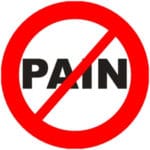We all know what pain is. And we know it comes in many different flavors – physical, psychological, emotional; acute, chronic; sharp, dull, burning, searing, excruciating, etc. – anything and everything that includes suffering or discomfort of any kind.
Sure, it can be helpful, like an early warning system or a corrective for when we are pushing too hard.
More often it’s unpleasant, unwanted, feared and debilitating. Which makes the way so many people cope with pain all the more impressive. It’s easy enough for me to put up with the residual pain I have in one foot following a surgery that didn’t go well. Yes, I feel it with every step, but it’s mild. It’s when I have more severe pain, even from a relatively benign cause like a migraine or stomach virus, that I lie (in bed, on the cold hard tile of my bathroom floor…) and feel awe at those who continue to make lunches for their children, show up at work, smile, read, function in any way in the face of this and far worse misery.
To me, that’s a form of heroism whether or not it’s continuous, whether or not it sometimes comes with tears or complaints. Such strength, momentary or enduring, should give us pause in the best of ways.

Here are three helpful things I’ve learner about pain in twenty years as a doctor:
1. It’s always subjective, so it’s always real, even when others can’t see or understand it. Sure people can lie, but you can’t tell from the outside whether or not someone is in pain. You need to ask them and listen to their answer.
2. A paraphrased quote from Bob Brody, an internist at San Francisco General Hospital, and the first pain specialist I ever met: “I’d rather occasionally give medicine to someone who tells me they need it when they don’t than ever withhold it from someone who really needs it.”
3. Things that help people manage pain: sleep, compassion, treatment of depression, medications

Finally, two at least somewhat related links:
1) the magazine Pain Pathways recently ran an interview with me about the book. It’s not specifically about pain per se but certainly pain in its many forms and the myriad incredible ways people cope with it was among my themes. The article includes discussions of:
– Why stories?
– From doctor to author
– A nudge in the right direction
– Inspiration for the reader
2) The New York Times “Visualizing Pain” slide show. These images speak to pain and humanity in varied and remarkable ways.

